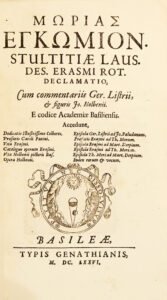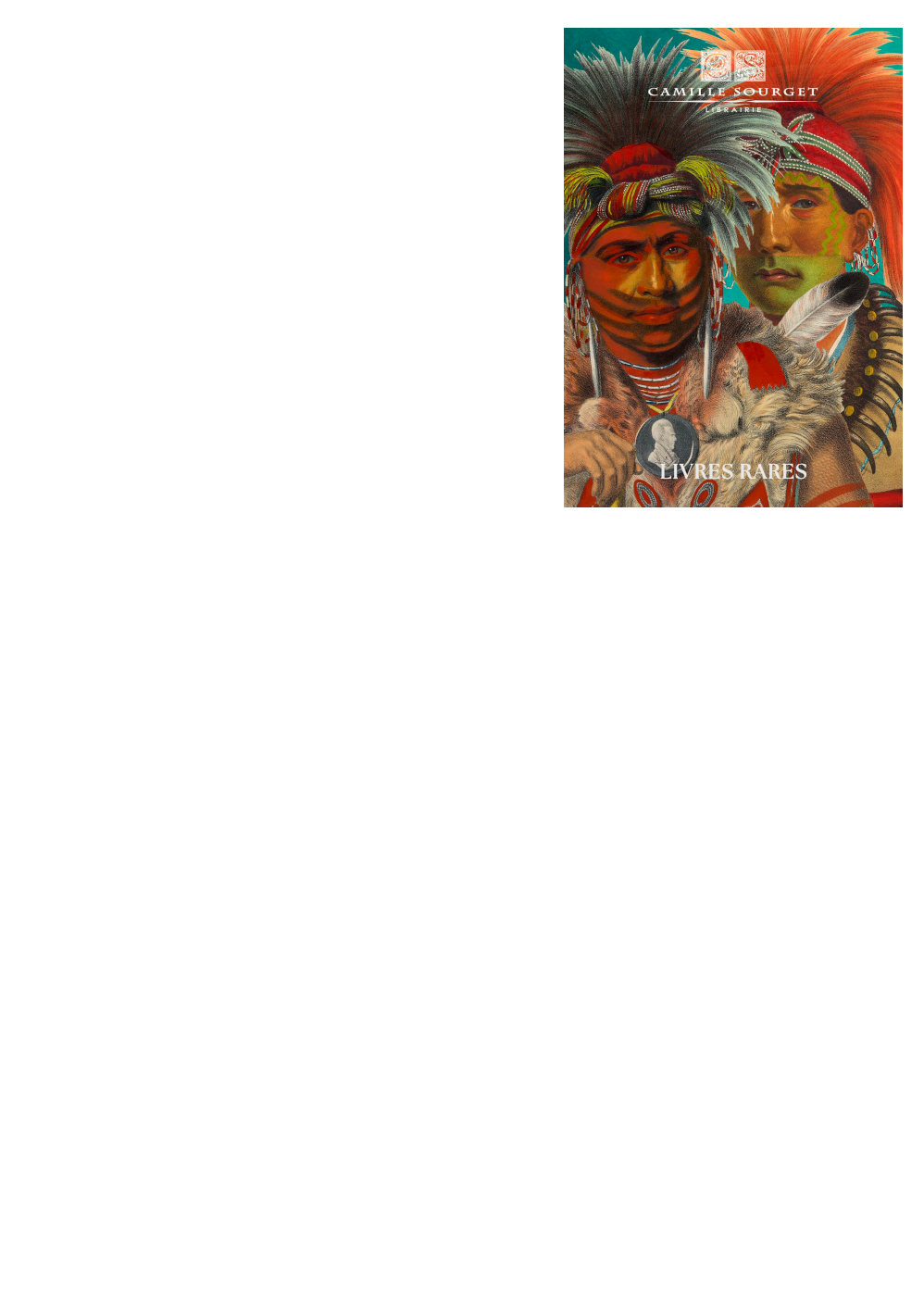Basileae typis Genathianis, 1676.
8vo of (40) leaves including a frontispiece with a beautiful frame, a portrait of Erasmus, two portraits of Holbein, 336 pages adorned with 81 engravings, 6 of which are folding, (6) leaves; full green morocco binding, triple gilt fillet framing the covers, decorated flat spine, inner gilt border, gilt edges. Superb binding by Derome le jeune, around 1780.
194 x 114 mm.
First, famous, and rare edition of “In praise of folly” by Erasmus.
Illustrated by Hans Holbein, this edition was published by Charles Patin, who dedicated it to Jean-Baptiste Colbert. The drawings by Holbein (reproduced from the drawings he composed in the margins of his copy of the Basel edition of 1515) were enlarged by the painter G. Settler, and the engraving was entrusted to Gaspard Merian.
“Engraved title-page after Holbein, second title-page with engraved device (‘patitvr nec dissolvitvr’), three engraved portraits after Holbein (Erasmus, Holbeins Elder and Younger), Erasmus’ memorial inscription, and 81 illustrations after Holbein, some of them quite curious (six of them mounted and folding).”
Brunet describes it carefully: “This edition is annexed to the Variorum collection: sold 19 francs in mor. Renouard; and in red morocco copy of Colbert, to whom the edition is dedicated, 78 francs De Bure. It has an engraved frontispiece, 40 preliminary leaves in which there is a portrait of Erasmus and two portraits of Holbein -, 336 pages of text, including two letters from Erasmus, one to Th. More, the other to Martin Daperius, and a letter from Th. More to the latter.
The figures by Holbein are printed in the text, sometimes exceeding its width, which made it necessary to glue them onto the book’s pages.”
Of Erasmus of Rotterdam (1467-1536), we hardly know more than his portraits painted by Holbein, Durer, Quentin Metsys, his friend, and a work, “In Praise of Folly”, associated with one word: humanism.
From this prominent figure of the Renaissance, Stefan Zweig gives us a portrait that restores his full dimension. A great traveler, Erasmus was the first thinker to define himself as European. Always in search of various knowledge, passionate about printing, he advocated for everyone’s access to culture and knowledge. An audacious reformer but fond of tolerance and dialogue, he denounced all fanaticisms, sought to avert the religious rupture that was about to drench Europe in blood. He was the first modern intellectual, spiritual father of Spinoza and Voltaire.
Hans Holbein the Younger (circa 1497 – between October 7 and November 29, 1543), a German artist and engraver, worked in a northern Renaissance style. He is best known for his numerous portraits and his series of woodcut engravings of the Dance of Death and is widely considered one of the finest portraitists of the early modern period.
Holbein was born in Augsburg and learned to paint from his father, Hans Holbein the Elder. In 1515, he and his brother Ambrosius Holbein moved to Basel, where they designed engravings, murals, and stained glass. During this period, Holbein created a famous series of pen and ink illustrations in the margins of a book belonging to his schoolmaster, “In Praise of Folly” by the Dutch humanist Erasmus. Holbein met Erasmus and later painted three portraits of him.
Precious and superb copy, one of the two cited by Brunet, elegantly bound in green morocco by Derome around 1780.
Provenance: D. N. Multz (armorial bookplate); A. A. Renouard!; Georges Heilbrun.

![Morias enkomion [Greek-letter] / Stultitiae laus. Des. Erasmi Rot. declamatio, Cum commentariis Ger. Listrii, & figuris Jo. Holbenii. E codice Academiae Basiliensis. Accedunt, Dedicatio illustrissimo Colberto, Praefatio Caroli Patini, Vita Erasmi; Catalogus operum Erasmi, Vita Holbenii pictoris Bas., Opera Holbenii, Epistola Ger. Listrii ad Jo. Paludanum, Praefatio Erasmi ad Th. Morurn, Epistola Erasmi ad Mart. Dorpium, Epistola Erasmi ad Th. Morum, Epistola Th. Mori ad Mart. Dorpium, Index rerum & vocum.](https://www.camillesourget.com/wp-content/uploads/2024/12/Titre-7-scaled.jpg)
![Morias enkomion [Greek-letter] / Stultitiae laus. Des. Erasmi Rot. declamatio, Cum commentariis Ger. Listrii, & figuris Jo. Holbenii. E codice Academiae Basiliensis. Accedunt, Dedicatio illustrissimo Colberto, Praefatio Caroli Patini, Vita Erasmi; Catalogus operum Erasmi, Vita Holbenii pictoris Bas., Opera Holbenii, Epistola Ger. Listrii ad Jo. Paludanum, Praefatio Erasmi ad Th. Morurn, Epistola Erasmi ad Mart. Dorpium, Epistola Erasmi ad Th. Morum, Epistola Th. Mori ad Mart. Dorpium, Index rerum & vocum. - Image 2](https://www.camillesourget.com/wp-content/uploads/2024/12/Portrait-1-scaled.jpg)
![Morias enkomion [Greek-letter] / Stultitiae laus. Des. Erasmi Rot. declamatio, Cum commentariis Ger. Listrii, & figuris Jo. Holbenii. E codice Academiae Basiliensis. Accedunt, Dedicatio illustrissimo Colberto, Praefatio Caroli Patini, Vita Erasmi; Catalogus operum Erasmi, Vita Holbenii pictoris Bas., Opera Holbenii, Epistola Ger. Listrii ad Jo. Paludanum, Praefatio Erasmi ad Th. Morurn, Epistola Erasmi ad Mart. Dorpium, Epistola Erasmi ad Th. Morum, Epistola Th. Mori ad Mart. Dorpium, Index rerum & vocum. - Image 3](https://www.camillesourget.com/wp-content/uploads/2024/12/Planche-1-3-scaled.jpg)
![Morias enkomion [Greek-letter] / Stultitiae laus. Des. Erasmi Rot. declamatio, Cum commentariis Ger. Listrii, & figuris Jo. Holbenii. E codice Academiae Basiliensis. Accedunt, Dedicatio illustrissimo Colberto, Praefatio Caroli Patini, Vita Erasmi; Catalogus operum Erasmi, Vita Holbenii pictoris Bas., Opera Holbenii, Epistola Ger. Listrii ad Jo. Paludanum, Praefatio Erasmi ad Th. Morurn, Epistola Erasmi ad Mart. Dorpium, Epistola Erasmi ad Th. Morum, Epistola Th. Mori ad Mart. Dorpium, Index rerum & vocum. - Image 4](https://www.camillesourget.com/wp-content/uploads/2024/12/Planche-2.png)
![Morias enkomion [Greek-letter] / Stultitiae laus. Des. Erasmi Rot. declamatio, Cum commentariis Ger. Listrii, & figuris Jo. Holbenii. E codice Academiae Basiliensis. Accedunt, Dedicatio illustrissimo Colberto, Praefatio Caroli Patini, Vita Erasmi; Catalogus operum Erasmi, Vita Holbenii pictoris Bas., Opera Holbenii, Epistola Ger. Listrii ad Jo. Paludanum, Praefatio Erasmi ad Th. Morurn, Epistola Erasmi ad Mart. Dorpium, Epistola Erasmi ad Th. Morum, Epistola Th. Mori ad Mart. Dorpium, Index rerum & vocum. - Image 5](https://www.camillesourget.com/wp-content/uploads/2024/12/Planche-4-4-scaled.jpg)
![Morias enkomion [Greek-letter] / Stultitiae laus. Des. Erasmi Rot. declamatio, Cum commentariis Ger. Listrii, & figuris Jo. Holbenii. E codice Academiae Basiliensis. Accedunt, Dedicatio illustrissimo Colberto, Praefatio Caroli Patini, Vita Erasmi; Catalogus operum Erasmi, Vita Holbenii pictoris Bas., Opera Holbenii, Epistola Ger. Listrii ad Jo. Paludanum, Praefatio Erasmi ad Th. Morurn, Epistola Erasmi ad Mart. Dorpium, Epistola Erasmi ad Th. Morum, Epistola Th. Mori ad Mart. Dorpium, Index rerum & vocum. - Image 6](https://www.camillesourget.com/wp-content/uploads/2024/12/Planche-5.png)
![Morias enkomion [Greek-letter] / Stultitiae laus. Des. Erasmi Rot. declamatio, Cum commentariis Ger. Listrii, & figuris Jo. Holbenii. E codice Academiae Basiliensis. Accedunt, Dedicatio illustrissimo Colberto, Praefatio Caroli Patini, Vita Erasmi; Catalogus operum Erasmi, Vita Holbenii pictoris Bas., Opera Holbenii, Epistola Ger. Listrii ad Jo. Paludanum, Praefatio Erasmi ad Th. Morurn, Epistola Erasmi ad Mart. Dorpium, Epistola Erasmi ad Th. Morum, Epistola Th. Mori ad Mart. Dorpium, Index rerum & vocum. - Image 7](https://www.camillesourget.com/wp-content/uploads/2024/12/Plnche-3-scaled.jpg)
![Morias enkomion [Greek-letter] / Stultitiae laus. Des. Erasmi Rot. declamatio, Cum commentariis Ger. Listrii, & figuris Jo. Holbenii. E codice Academiae Basiliensis. Accedunt, Dedicatio illustrissimo Colberto, Praefatio Caroli Patini, Vita Erasmi; Catalogus operum Erasmi, Vita Holbenii pictoris Bas., Opera Holbenii, Epistola Ger. Listrii ad Jo. Paludanum, Praefatio Erasmi ad Th. Morurn, Epistola Erasmi ad Mart. Dorpium, Epistola Erasmi ad Th. Morum, Epistola Th. Mori ad Mart. Dorpium, Index rerum & vocum. - Image 8](https://www.camillesourget.com/wp-content/uploads/2024/12/Reliure-fond-gris-scaled.jpg)
